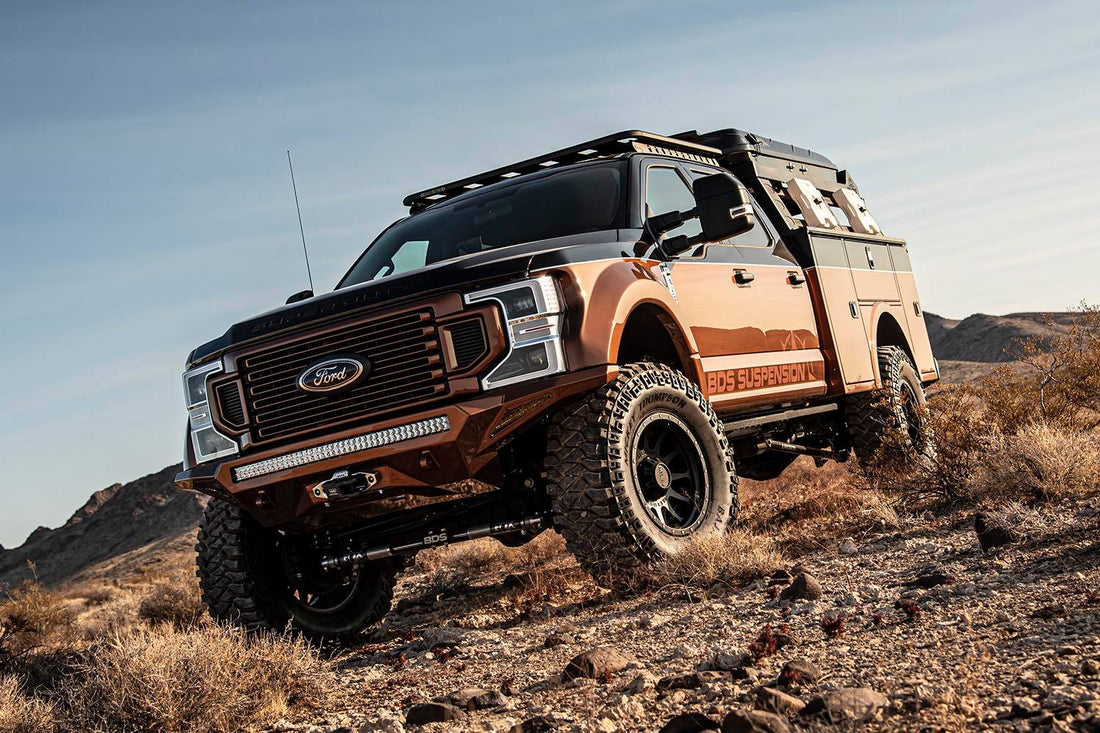
How High Should You Lift Your Truck? A Technical Guide to Choosing the Right Lift Kit
Share
Truck lifts aren’t just about looking tough (although let’s be honest, that’s a big perk). The right suspension lift improves off-road capability, ground clearance, tire fitment, and even ride quality—if you pick wisely. In this post, we’ll break down how lift kits work, how to determine the ideal lift height, and compare popular brands like BDS, Rough Country, Carli, and Fabtech.
Let’s dive (or climb) in.
1. First, Know the Three Types of Lift Kits
| Lift Type | Height Range | What It Does | Best For |
|---|---|---|---|
| Leveling Kit | 1–2 inches (front only) | Eliminates factory rake | Looks & larger tires |
| Suspension Lift | 2–10+ inches | Raises frame & suspension system | Real off-road performance |
| Body Lift | 1–3 inches | Lifts body off frame with spacers | Tire clearance on a budget |
2. How High Is “Right”? Start With Your Goal
Before throwing money at a lift kit, ask yourself:
✅ A. What’s the primary use of the truck?
-
Daily driver: 2–4"
-
Weekend off-road: 4–6"
-
Show truck / extreme off-road: 6–10"+
✅ B. What tire size do you want to run?
| Tire Size | Typical Lift Required |
|---|---|
| 33" | 2–2.5" leveling or small lift |
| 35" | 4–6" lift |
| 37" | 6–8"+ lift, trimming often required |
| 40"+ | 8–12"+ and major modifications |
✅ C. Will performance or budget matter more?
-
If budget is priority → Rough Country, MotoFab, ReadyLift
-
If ride quality / durability is priority → BDS, Carli, Fox, Icon
3. Suspension Geometry Matters More Than Height
Lifting isn’t just “make truck tall.” Go too high without correcting geometry and you’ll ruin ride quality or wear parts fast.
What changes as height increases?
-
Driveshaft angles
-
Control arm angles
-
Steering linkage
-
Brake line length
-
Shock travel
-
Center of gravity (roll risk)
Rule of Thumb:
Over 4" of lift? You need full replacement components, not just spacers.
4. Popular Lift Kit Brands (and what they’re known for)
BDS Suspension
-
Extremely durable
-
No fine-print warranty (even off-road)
-
Full replacement components
-
Premium price, premium quality
Best for: Long-term reliability, serious off-roaders, people who hate cheap kits.
Rough Country
-
Affordable and widely available
-
Spacer kits, basic shocks, decent ride
-
Newer premium lines: V2 and Vertex shocks
Best for: Budget builds, daily drivers, “looks first” trucks.
Carli Suspension (especially for Ram/Ford HD)
-
Engineered specifically for ride quality & articulation
-
Tuned shock systems (King, Fox)
-
Expensive but unmatched comfort
Best for: High-end performance, overlanding, tow + ride comfort builds.
Fabtech / Zone / ReadyLift
-
Mid-level options
-
Mix of spacers and replacement parts
-
Good value and brand support
Best for: Balanced performance and price.
5. Drivetrain & Axle Considerations
The higher you go, the more stress you put on your truck.
At 2–4 inches:
-
Usually fine with basic geometry corrections.
At 4–6 inches:
-
Extended brake lines
-
Drop brackets or longer control arms
-
Steering stabilizer recommended
-
Re-gearing for larger tires becomes smart
Above 6 inches:
-
Driveshaft replacement or CV-style shafts
-
Longer shocks and reservoirs
-
Sway bar drop brackets
-
Possible track bar relocation
-
Re-gear is almost mandatory
-
Upgraded axles if running 37s/40s
6. Legal and Safety Limits
Before you build a skyscraper:
✅ Check state lift laws (some limit bumper or headlight height).
✅ Consider your center of gravity (higher = more rollover risk).
✅ Will it still tow safely?
✅ Will it still fit in the drive-thru? (very scientific but crucial)
7. Daily Drivability vs Off-Road Capability
| Height | Pros | Cons |
|---|---|---|
| 2-3" | Great ride, easy, affordable | Limited tire size |
| 4-6" | 35s fit, off-road capable | More parts to replace, cost rises |
| 6-8"+ | Huge presence & ground clearance | Geometry issues, cost, harder to drive |
8. Cost Breakdown by Lift Size
| Lift Size | Typical Cost (Parts + Install) |
|---|---|
| Leveling Kit ($100–500) | $300–$800 installed |
| 4–6" Quality Suspension ($1500–$3500) | $2k–$6k installed |
| 6–10" Premium ($3500–$8000+) | $5k–$15k+ installed |
Add another $1,200–$4,000 for wheels, tires, gears, and supporting mods.
9. Want the best lift? Install matters more than the box.
Even the best lift kit will ride terribly if installed by someone who doesn’t know suspension and alignment geometry.
Look for a shop that:
-
Specializes in lifted trucks
-
Performs custom alignments
-
Understands steering corrections
-
Installs BDS, Carli, Fox, or Rough Country regularly
10. Final Checklist: How High Should YOU Go?
✅ How do you use your truck?
✅ What tire size do you want?
✅ Daily driver or off-road toy?
✅ Are you willing to re-gear or upgrade axles?
✅ Budget vs performance?
✅ Do you care more about ride quality or looks?
The Sweet Spot for Most Trucks:
4–6” lift + 35s
-
Perfect balance of stance, capability, drivability, and cost.
